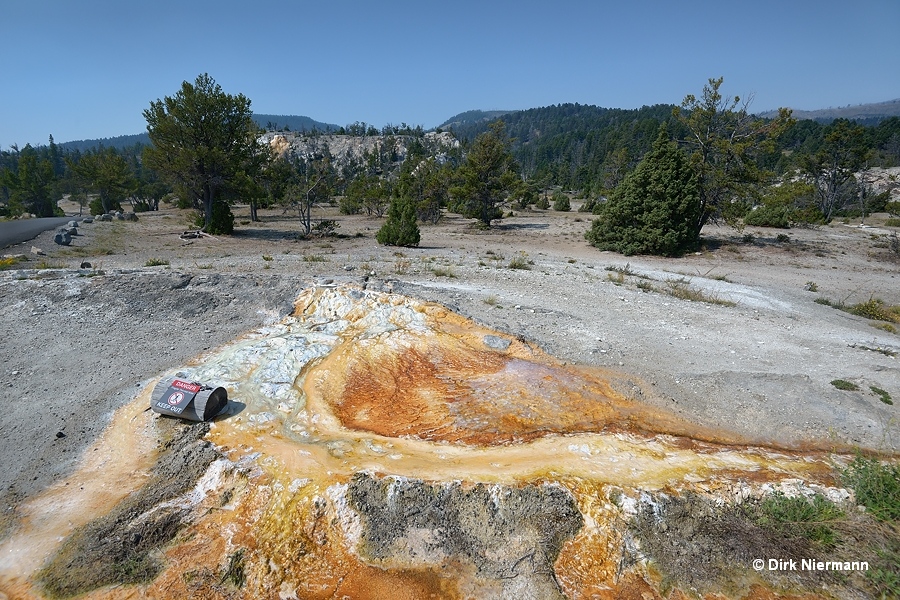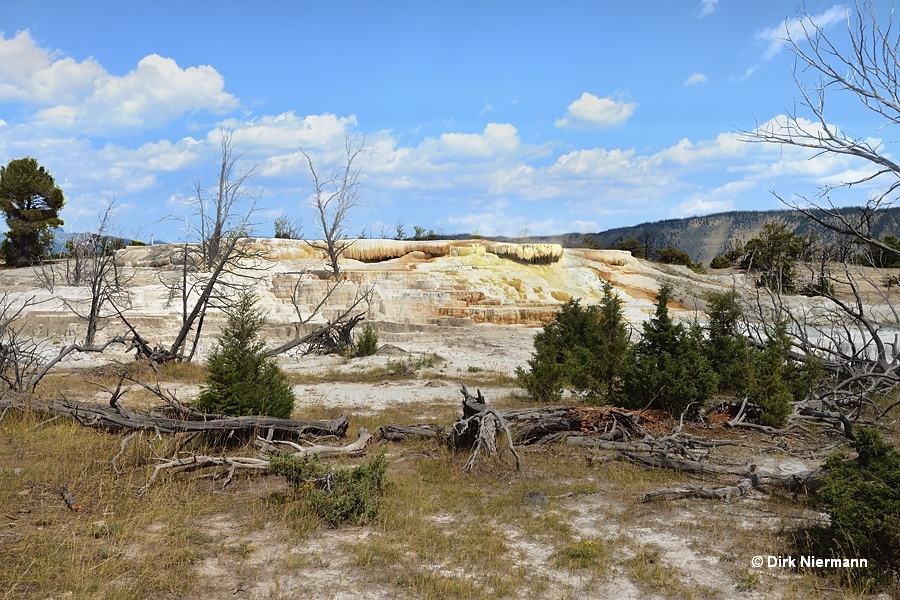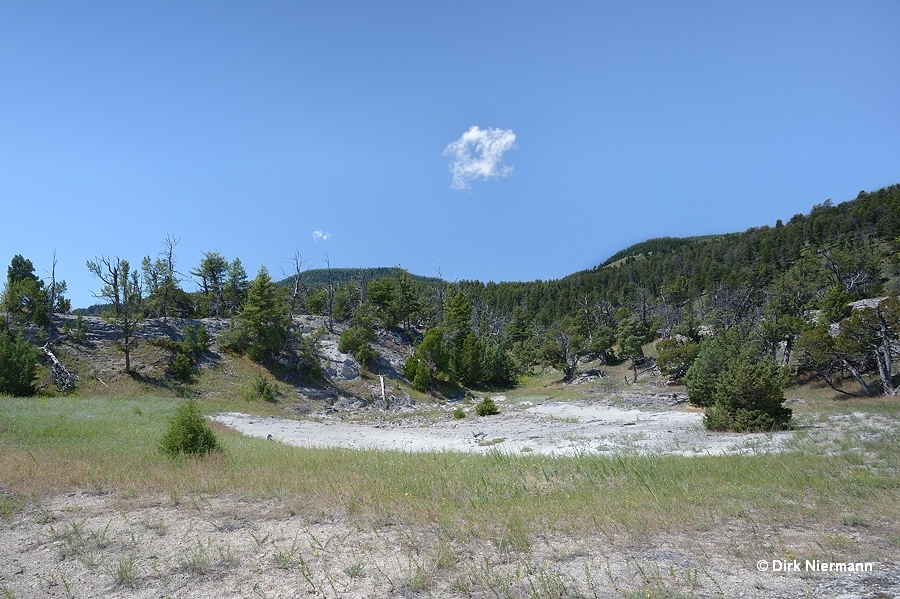Mammoth Hot Springs, Upper Terraces
Page 1 2
The Upper Terrace Drive at Mammoth Hot Springs gives access to travertine formations and hot springs southwest of the Main Terrace Area. It is an one-way loop road open to cars, bicycles, and hikers. During the main season parking in front of the different features is often quite tricky because space is limited. Therefore, it is always a good idea to hike the 1.5 mile loop.
In July 2015 the National Park Service temporarily closed Upper Terrace Drive to vehicles due to a new hot spring that had emerged in April 2015 from a fissure next to the parking lot just across the road west of Cupid Spring. Activity of this spring continued with interruptions into early 2016. A look into the history of Mammoth Hot Springs reveals that this is a reincarnation of Baby Spring, which was intermittently active at the same spot during the years 1932-65. It is also the namesake of Baby Terrace, a sub-terrace of Prospect Terrace and the support structure of the current parking lot.

Investigations with the help of drillholes and thermal imaging infrared cameras showed that the feature's hot water conducting veins are continuing underneath the pavement of the parking lot. This may necessitate closures or reconstruction work in the area also in future. Interestingly, in the pictures it can be seen that the outflow channels of the spring and the drillhole are already densely populated by thermophiles, raising the question of how they can arrive so quickly. A possible answer may be the presence of a "deep, hot biosphere" in subsurface environments, a concept developed 1992 by Thomas Gold and supported by many research results since then.

West of Baby Terrace the Loop Road passes Narrow Gauge Terrace. Close to the road you find a sign with its name, but apart from this at best small, inconspicuous patches of flowing water could be seen until the beginning of the 2020s. While the northwestern section of Narrow Gauge Terrace showed high activity already in the 2010s, the new decade saw a fulminant awakening of the southeastern part close to the road.

Narrow Gauge Terrace got its name because the elongated shape of the main fissure ridge resembles an old-time narrow-gauge railroad track bed. As with most fissure ridges it is characterized by a crack that extends along the top of the ridge for nearly its entire length, caused by a tension fracture. When water is flowing out of this crack, the hydrostatic pressure can be so huge that small fountains rise into the air. In the picture above such a fountain can be spotted atop the rear part of the visible ridge. The next pictures show a close-up of the fountain.

The best viewpoint for the northwestern section of Narrow Gauge Terrace can be reached on the Howard Eaton Trail. On regular inspections from the 2010s to the mid 2020s one could have observed activity gradually advancing along the fissure ridge from northwest to southeast. The aprons around vents of Narrow Gauge Spring are well known to microbiologists for hosting almost uniform communities of white, filamentous Sulfurihydrogenibium yellowstonense, hyperthermophilic bacteria of the Aquificales group. In the temperature range of 70 °C to 74 °C (158 - 165 °F) prevailing in the vents they are obtaining energy via metabolism of sulfur compounds. The white streamers, which are recognizable on the images of New Baby Spring and of the drillhole near New Baby Spring shown above are very likely formed of Sulfurihydrogenibium bacteria, too.

The vaguely pyramidal shaped terracette assembly of Cheops Mound shows up not far southeast of the Narrow Gauge Fissure Ridge. For the early history of Yellowstone only one recorded activity around 1904 is known from the Cheops Mound Fissure Ridge. The more surprising was a reactivation in the early 2000's, when an additional spring came to life in a forested area. Since then many trees died and an impressive new mound has grown up. Because this new structure does not exactly match the position of the historical Cheops Mound terracettes some feet further east, it is more like a "Chephren Mound". In 2017 hot spring activity suffered an almost complete standstill and shifted towards the near Narrow Gauge Fissure Ridge, where many active vents appeared during that year.

At the next stop along Upper Terrace Drive a sign shows the name Prospect Terrace. This may be a little bit confusing because Prospect Terrace is an expanded area and comprises The Esplanade, Cupid Spring, Baby Terrace, and the Prospect Springs. The weathered sinter cone next to the loop road is the remains of one of the Prospect Springs. They ceased flowing at the end of the 1960s.

New Highland Terrace was formed by New Highland Spring from 1928 through to the 1980s in a forested area. Some of the embedded trees can still be seen today. New Highland Terrace is only a part of the extensive Highland Terrace proper where some prominent springs are located in areas that are now inaccessible and secluded. Cedar Tree Spring, which showed discharge from 1961 to the early 1970s, is one example. Probably around 2011 New Highland Spring developed a new generation of vents just in the middle of the northern edge of New Highland Terrace, whose runoffs are visible from the road. The strongest one is shown in the next picture. If you look very closely, you may spot a little gas driven water fountain on top of the spring.

West of the active vents some old, partially broken terracette deposits of New Highland Spring line the edge of the terrace.

Immediately south of New Highland Terrace, Orange Spring Mound appears. This impressive mound on Highland Terrace is an intermittently active hot spring supported by a fissure ridge. Due to the low water discharge it is growing quite slowly and has built up the characteristic cone shape over a long period of time.

For long years the central vent of Orange Spring on top of the mound had been the dominant one, but since 2009 the discharge gradually shifted to a vent on the nothwestern flank and rendered the central vent almost dry. Of course, all vents are part of the same fissure, but the hot water conducting vein system is obviously constantly reshaping itself. The pictures show, furthermore, how the step-by-step longitudinal growth of such a fissure ridge takes place.

Tangerine Spring is one of the cones of Orange Spring Mound and fed through the same fissure, but has gotten an own name.

Across the road from Orange Spring Mound the small travertine cone of Little Burper shows up. From a vent on top often a carbon dioxide driven fountain of a few inches height could be seen before the spring ceased flowing at the end of the 1990s.

Two curves farther from Orange Spring Mound you can spot Aphrodite Terrace at some distance on the lefthand side (east) of the road. At this location flowing water was observed for the very first time in 1978, gradually building up terrace structures, which were named by Yellowstone's historian Lee H. Whittlesey. After some time of dormancy Aphrodite Spring came back into action around 2013.

On a closer look, Aphrodite Spring displayed breathtaking terracette deposits with appealing pastel colors in summer of 2017. To the disappointment of visitors in subsequent years, already in autumn of 2017 the beautiful overhangig terracette deposit collapsed and, even worse, the spring ran dry. It remains to be seen when it comes back to life.

The Devil's Kitchen Cave as well as the Devil's Kitchen Springs southeast of Aphrodite Terrace are not visible from legal observation points. The Devil's Kitchen had been open to visitors until 1939, but then it was closed due to an unpredictably changing carbon dioxide concentration in the air and lack of oxygen. Repeatedly, huge numbers of animals, mostly birds, were found dead inside the caves due to poisoning by carbon dioxide. A short distance southwest of Devil's Kitchen the Rath Terrace is likewise obscured from Upper Terrace Drive. According to Lee H. Whittlesey, Rath Spring became active again from 1997 to 2000 after more than 100 years of dormancy.
Across the road of Aphrodite Terrace the dry basin of Bath Lake is still recognizable. Many times in history Bath Lake ran dry and got refilled, for the last time it contained water from 1959 to 1984. Its moderate temperatures between 38 and 64 °C (100 -147 °F) tempted many visitors to go swimming, hence the name. Even if Bath Lake was quite shallow and swimming was permitted in the old times, it did not prevent bathers from drowning. At least two men drowned in Bath Lake, one in 1889 and the other one in 1898.

Another fissure ridge farther south is poetically called White Elephant Back Terrace. Usually, White Elephant Back Spring is far less active compared to the ones on Orange Spring Mound. So there are only minor traces of thermophilic organisms visible.


Page 1 2